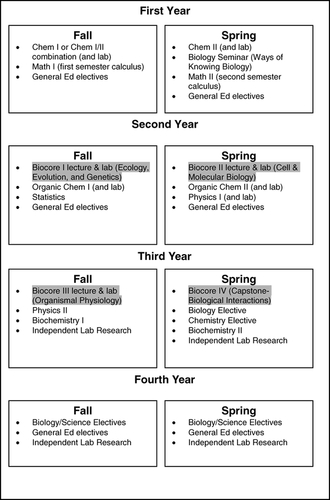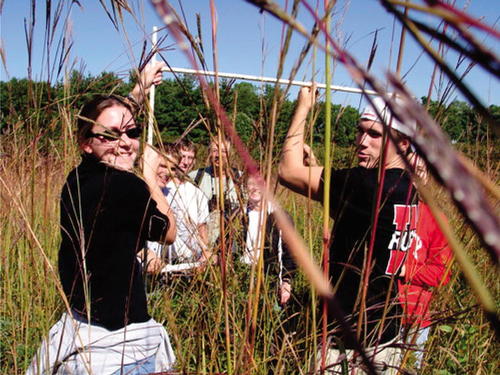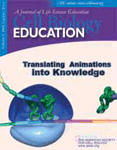Points of View: A Survey of Survey Courses: Are They Effective?
“Why four semesters? How does this track differ from the two-semester course sequence?” These are the most common questions students have when they learn about the Biology Core Curriculum (Biocore), a unique four-semester honors biology sequence at University of Wisconsin-Madison (UW-Madison).
Before I began teaching in and sharing the administration of Biocore, I had the same questions. My only experience with introductory biology curriculum, prior to coming to UW-Madison 21/2 years ago, had been at large research universities that offered the traditional two-semester foundation courses, with one course in “organismal biology” that included ecology, evolution, transmission genetics, a little bit of physiology, and a survey of all known phyla. The complementary course, offered either before or after the organismal course, focused on cell and molecular biology and covered cellular anatomy, metabolism, bioenergetics, and gene expression and regulation. A 1-year introductory pair of survey courses seems to be the norm, either as a lecture-only format or paired with optional/required laboratory courses. The two survey courses serve as prerequisites for upper-division course work that provides more in-depth, intermediate, and advanced material. Sound familiar? My experience working in Biocore has convinced me of the merits of a four-semester approach, expanding on and integrating concepts and skills with the continuity that the increased time and contact allow.
HISTORICAL PERSPECTIVE
Biocore was first taught at University of Wisconsin in 1967. At the time, it was felt by many administrators and faculty that the teaching of biology at the undergraduate level lagged behind the rapid advances in our knowledge of biological systems and that the curriculum was constrained by departmental boundaries, compartmentalized as either animal or plant based and taught as such in the Departments of Zoology or Botany. The introductory courses in these departments were somewhat redundant, were taught only by faculty within those departments (even though there were about 15 other departments on campus associated with biology at the time), and did not challenge students to recognize the fundamental similarities across all biological systems. In response to this problem, a group of faculty recommended that a core curriculum be established that was bolstered by courses in mathematics and the physical sciences. In designing such a curriculum, the faculty“ founders” sought models for nontraditional, integrated, interdepartmental programs. Their ideas were influenced by leaders such as Clifford Grobstein. Grobstein was a forward-thinking cell biologist from Stanford and University of California-San Diego, a nationally recognized researcher in embryonic development, and a great thinker and communicator of new ways to organize biological knowledge for teaching (Grobstein, 1966; Wessels, 2000). What the UW-Madison campus took from the work of Grobstein and others was a call to involve faculty from across the campus—from the medical school and from the Colleges of Agriculture and Letters and Science—in the teaching of biology. What the UW-Madison faculty developed was a challenging, four-semester honors course sequence intended for students who plan to go on to graduate or professional school. One main focus for the new curriculum would be a laboratory progression where students could experience and develop their understanding of the process of science firsthand. Key to the program's success was the enthusiastic backing by the deans of the major colleges and the chancellor of the university.
Although the program has changed and evolved over its history, the basic goals, philosophy, program structure, and administrative support have remained the same. Four semesters (2 years) may seem a bit extreme, but the rationale was that modern biology cannot be taught effectively without a strong background in chemistry, math, and physics, and that true integration and development of students' knowledge takes time and requires continuity. The impetus, goals, and recommendations outlined nearly 39 years ago are strikingly similar to those laid out in the recent Bio2010 report (National Research Council, 2003). Although the curriculum lacks the emphasis in computer science and physics, it most highly resembles that of “potential curriculum C” outlined on p. 57 of Bio2010.
THE CURRICULUM
Students do not begin their biology course work in Biocore until the fall of their sophomore year. The rationale for this timing is that students cannot gain a deep understanding of biology without first establishing a firm grounding in chemistry and math. The sample course curriculum illustrated in Figure 1 allows for component Biocore courses to be integrated with one another and with chemistry, math, and physics courses that are taken previously or concurrently. The Biocore sequence begins with an overview of evolution, ecology, and transmission genetics in Biocore I; moves into cell and molecular biology in Biocore II, with great emphasis on chemistry and bioenergetics; continues with physiology in Biocore III, where students apply physics, chemistry, and math in their study of both plant and animal physiology; and culminates in a capstone experience in Biocore IV. In Biocore IV, students synthesize concepts and skills learned over the previous three semesters of lecture and lab and apply what they have learned to studies of the primary literature using a cooperative learning pedagogical model (Burgess, 2002). Laboratory courses focus on the process of science and challenge students to develop their own independent research projects, with topics drawn heavily from the lecture courses as well as their math, chemistry, and physics experiences. Labs are structured so that over three semesters students gradually gain a high level of sophistication and confidence in doing independent research in the language and conventions of the discipline. All laboratory courses stress making observations (Figure 2), designing tests for hypotheses, drawing conclusions based on evidence, and writing reports in the form of scientific papers. The courses are writing intensive and challenge students to analyze and think critically about scientific data.
Figure 1. This example sequence shows a typical progression for a student through a biological science major at UW-Madison integrating Biocore into a 4-year course plan. The first two Biocore courses are introductory courses while the third and fourth are intermediate. Genetics is taught formally in Biocore I and II and integrated into Biocore III and IV so that many majors do not require an upper-level Genetics course. Students typically seek out and do independent research in research faculty labs starting in their sophomore or junior year unless they study abroad. This research experience usually sets them up for a senior thesis project in their fourth year.
The primary learning objectives for a Biocore student are to:
Utilize experience, knowledge, and creativity to solve complex biological problems.
Understand how we know what we know in biology through study of the nature of science, the primary scientific literature, and historical experiments.
Build a logical argument based on evidence, learn to think critically, be skeptical, look at evidence before believing, and understand that there is not always just one right answer to a question.
Use terminology accurately and effectively within appropriate conventions of the discipline.
Frame sophisticated biological questions, formulate testable hypotheses, design and carry out experiments, and make logical conclusions based on evidence.
Analyze a problem using a systems approach (“systems thinking”), recognizing levels of biological organization and emergent properties of the whole.
Express ideas clearly and logically in oral and written form.
Know how to find and evaluate information.
Work as a member of a productive, collaborative research team.
Identify how biological structure follows function and recognize how this phenomenon results from the process of evolution.
Admission to Biocore is by application only. Because we know that four semesters is a big commitment, we want to give students an opportunity to carefully consider their options. We ask them to fill out a short application and write a brief essay (see http://www.biocore.wisc.edu/biocore for the most recent application). The application also allows us to recognize students who we think will have the greatest likelihood of success. Although we look for students who have reasonable grades in their chemistry and math prerequisite courses, we know that the first year of college GPA does not always represent a student's capacity for achievement in Biocore. Therefore, we also look at their motivation for applying, the achievement of which they are the most proud (this provides for the most interesting responses!), and how well they can formulate an argument in their essay.
Given the challenging pace and degree of sophistication that we expect, the courses quickly rise above introductory level. That said, not all students meet the challenge or “buy in” to the program's philosophy, and there is attrition of roughly 10 to 15 percent per semester. Some students leave the program after two semesters because their major does not require the full sequence. Of the 150 to 160 students who enter the sequence and move through together as a cohort, approximately 85 complete all four semesters. These 85 students proceed to upper-level courses during their junior and senior years. In a recent survey of students' future plans after leaving Biocore, 57 percent planned to apply for medical school, 22 percent graduate research in fields from genetics and bioinformatics to biomedical engineering and conservation biology, 8 percent public health, 7 percent dental school, 2 percent vet school, 2 percent law school, and 2 percent undecided.
Elements that have been crucial to the program's success (or staying power) are: 1) strong advocates in higher university administration; 2) a dedicated and enthusiastic group of volunteer faculty who not only are outstanding scientists but are eager to experiment with their teaching; 3) program autonomy, such that our reporting and funding lines are independent from a department; 4) the same permanent academic staff in lab through three semesters, providing continuity and high standards for continuous intellectual development of students; and 5) a small and responsive program staff that can quickly help adjust curriculum as knowledge in the field advances. This last point is very important, because integration and innovation require frequent communication among faculty, teaching assistants, and program coordinators. The courses are team-taught by faculty drawn from all over the campus. Typically, three faculty members participate in each course, attend each other's lectures, and meet regularly to plan and develop course materials. Each course is coordinated and led by one of the participating faculty, the course chair. Course chairs of all seven courses (four lectures and three labs) meet monthly to help maintain continuity, problem-solve, and develop new initiatives. Many faculty develop great loyalty to the program, demonstrated by the fact that of the 60 faculty who have taught in the program since its inception, 18 have taught for more than 15 years.
Figure 2. Students in Biocore I lab (Ecology, Evolution and Genetics) take field measurements of foliage height in the Biocore Prairie. Students in this class are restoring a 5-acre, old agricultural field to tallgrass prairie. In the process, they are learning ecological principles and methods that they return to during the third semester lab when they utilize the prairie to study plant physiology. Some students choose to extend their studies into the summer months when they can spend concentrated time doing research during the growing season. The Biocore Prairie provides the context for authentic research experiences and a focus for teaching environmental stewardship.
WHAT DO STUDENTS GET OUT OF THE SECOND YEAR?
Central to this question is the program focus on integration and intellectual development of students. Integration is especially important in the second year, when students are introduced to organismal (plant and animal) physiology (which brings together study of seemingly disparate systems). Biocore III ties together the ecology and structure of an organism with organ-/tissue-/cellular-/subcellular-level functions utilizing an evolutionary perspective. The fourth-semester capstone course takes students a step further, allowing for deep exploration of a topic through readings and analysis of the primary literature, much like a graduate seminar. There are no textbooks (besides those purchased in previous semesters), and topics range widely and are dependent on the instructors' and students' interests. This provides for exciting discovery and discussion for both the faculty and students.
Although we have not systematically studied how students develop over the 2 years, we have designed many different types of assessments to get a handle on student learning. Given a smaller class size, instructors can assess learning in a qualitatively different fashion, including writing-intensive assignments and exams and many opportunities for discussions and oral communication of student scientific understanding. With greater student-to-instructor contact over four semesters, we are able to get to know students very well and can evaluate their level of understanding and development more effectively than we could in a large class over two semesters. Overall, there is an attempt to simulate the learning and teaching environment of a small college classroom rather than a large university survey course. All of these features are essential for maintaining quality control and ensuring a productive learning environment; however, the effort is quite resource intensive. The amount of“ resources” consumed per student taught, when dollars and person-hours are considered, is undoubtedly higher than the alternative two-semester sequence.
One problem that complicates the issue is that students come in thinking that their success in biology courses depends on their ability to memorize. Much of the introduction to any domain of learning is driven by vocabulary and definitions associated with an unconnected basket of “facts.” Biology is particularly messy in that way because “the facts” depend so heavily on weaving together research approaches at several levels of organization (from molecules to biosphere) and a strong foundation in chemistry, physics, mathematics, and statistics. It takes time for students to mature beyond memorization and thinking that all knowledge is certain and absolute. Evidence of this lower level of thinking is the often-heard statements “tell me what I need to know” and “I read it in the textbook or heard it from my professor, so it must be true.” It almost comes as a surprise and epiphany when students recognize that“ the facts” are constantly changing branches of knowledge that are relativistic and intertwined. We want students to appreciate that they have control and responsibility for constructing their own knowledge. In Biocore, a critical stage in maturation seems to take place at the end of the second and beginning of the third semesters, when students are familiar with the expectations, goals, their peers, and the learning environment, and they are ready to critically engage in the science of biology.
In uncommon circumstances, students may reach this higher level of intellectual development naturally. But the maturation process is much slower when they don't realize the goal, or haven't been challenged in that direction, or given the support and guidance to get there. If undergraduates have experienced this epiphany at a large research university, they likely attribute their development to one-on-one mentoring in a research lab.
I would argue that it is rare to find a curriculum at a large research university that actively fosters discipline-specific intellectual development in a systematic way. I would argue further that it is the responsibility of faculty at research-intensive universities to implement curriculum that facilitates this type of development. One could counter and say that not all students intend to pursue careers as scientists, and that it is the responsibility of upper-level courses to facilitate learning at this level of sophistication. However, it is rare that upper-division courses can provide an integrative treatment of biology, since they are often not well coordinated with introductory courses. Instructors struggle with students' differential preparation and may complain that they spend too much time covering remedial material that students should have come in knowing.
It is only under unusual circumstances that I have observed students come out of upper-division courses in a traditional curriculum with a true appreciation of the big-picture questions in biology today: How do biologists ask questions and do their science? How is everything in biology integrated and connected at multiple levels? Many students do achieve this level of intellectual maturity during their experience in Biocore. Their examples continue to convince faculty, administrators, and prospective students of the value of a four-semester approach at UW-Madison.
ACKNOWLEDGMENTS
I would like to thank Ann Burgess, Kelly Clifton, Jim Crow, and Millard Susman for historical insight and wonderful perspective. Many thanks to Jeff Hardin, Michelle Harris, and Malcolm Campbell for thoughtful review and to the other Points of View contributors for sharing their perspective and ideas.



